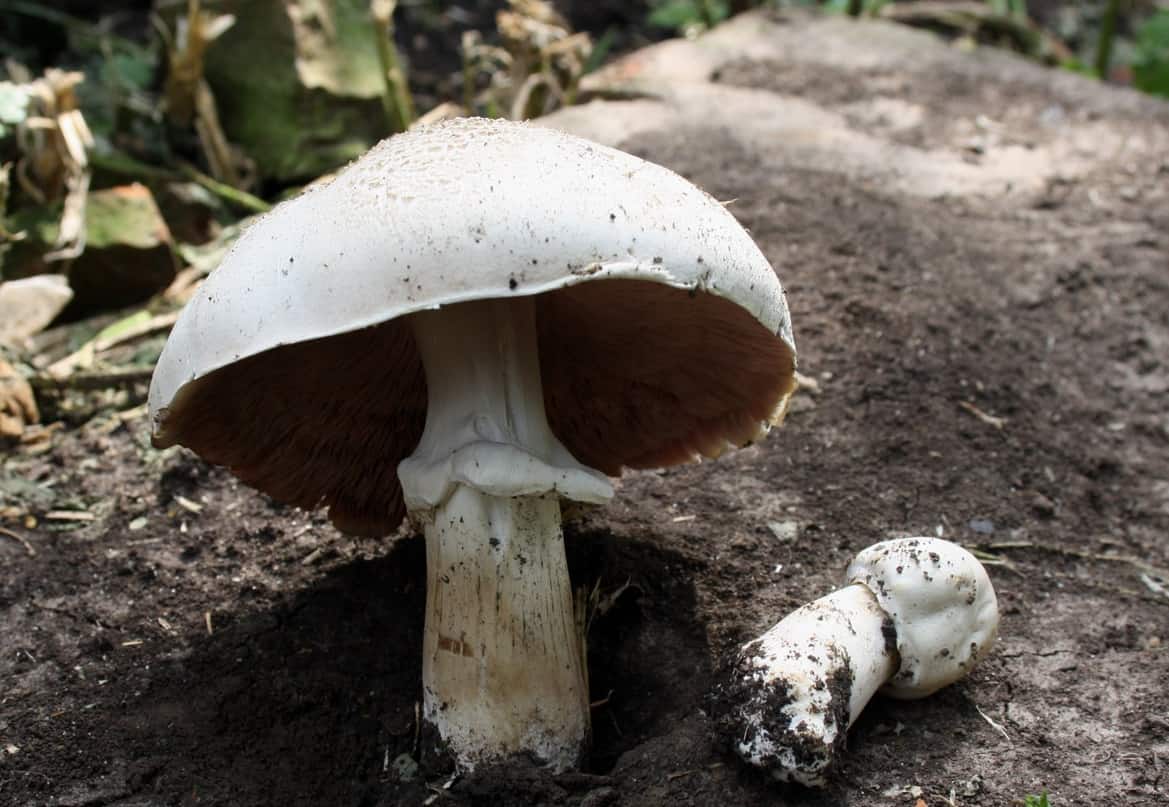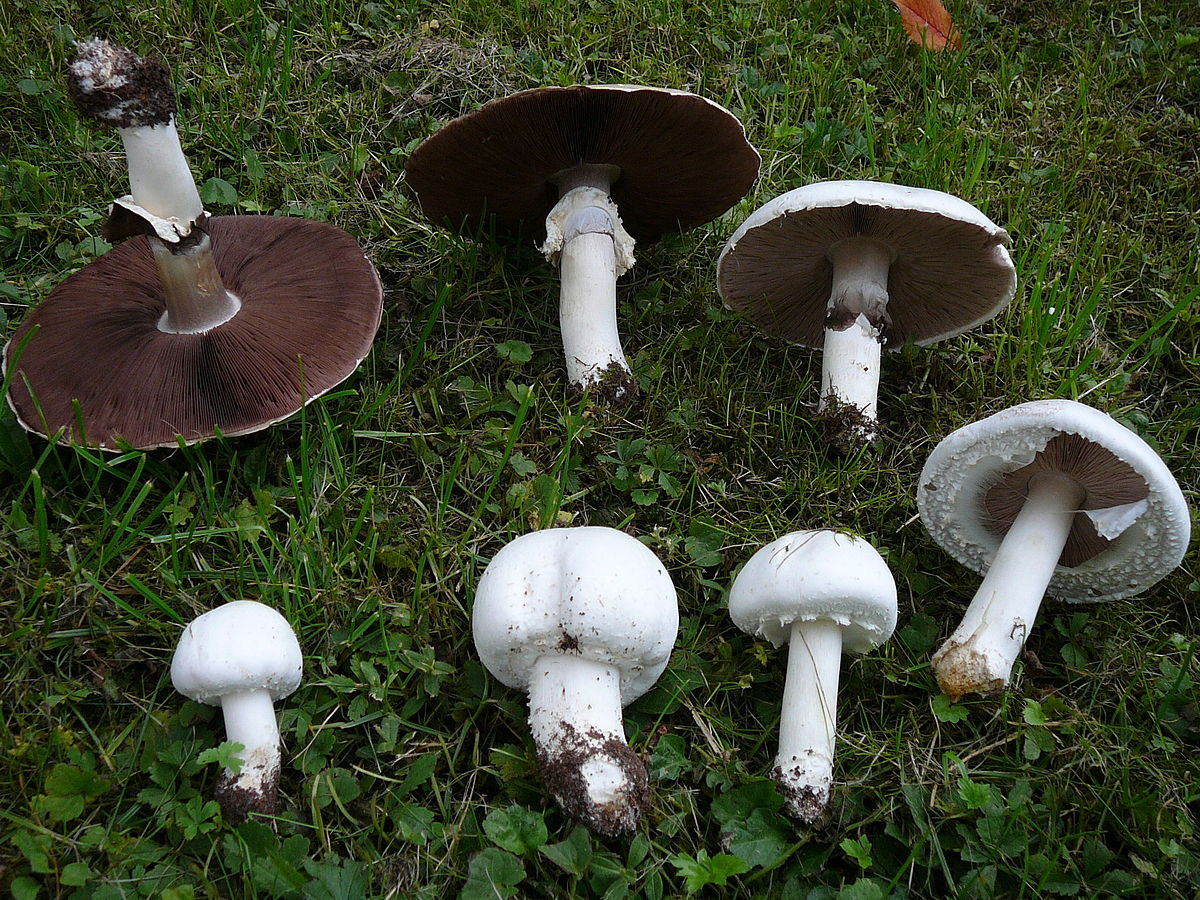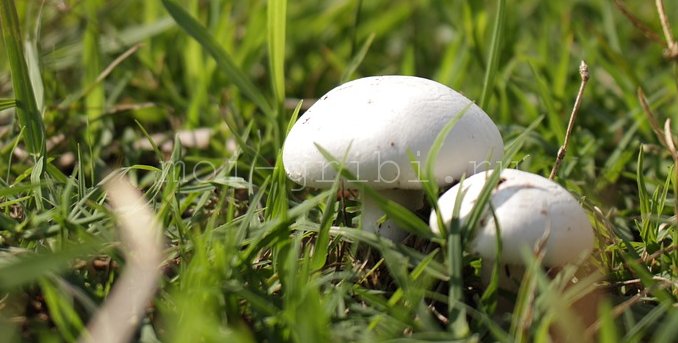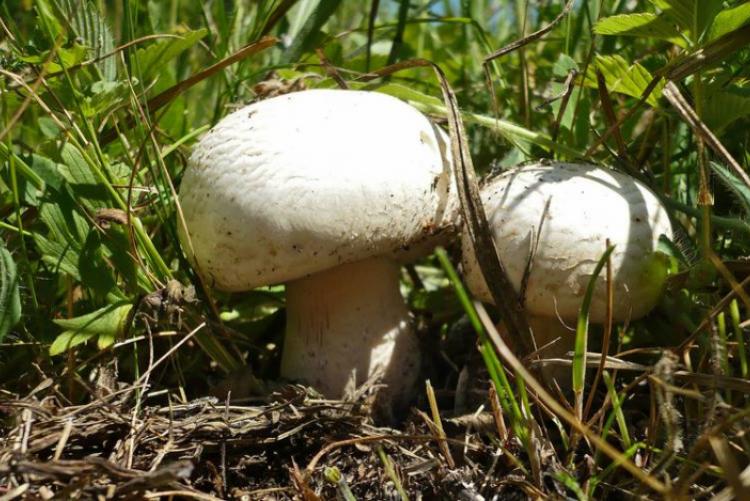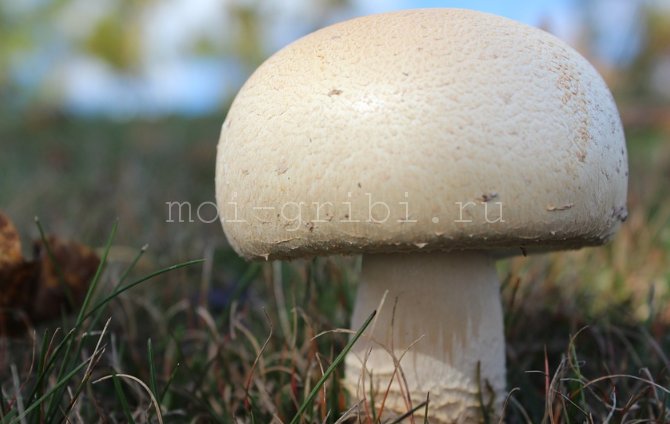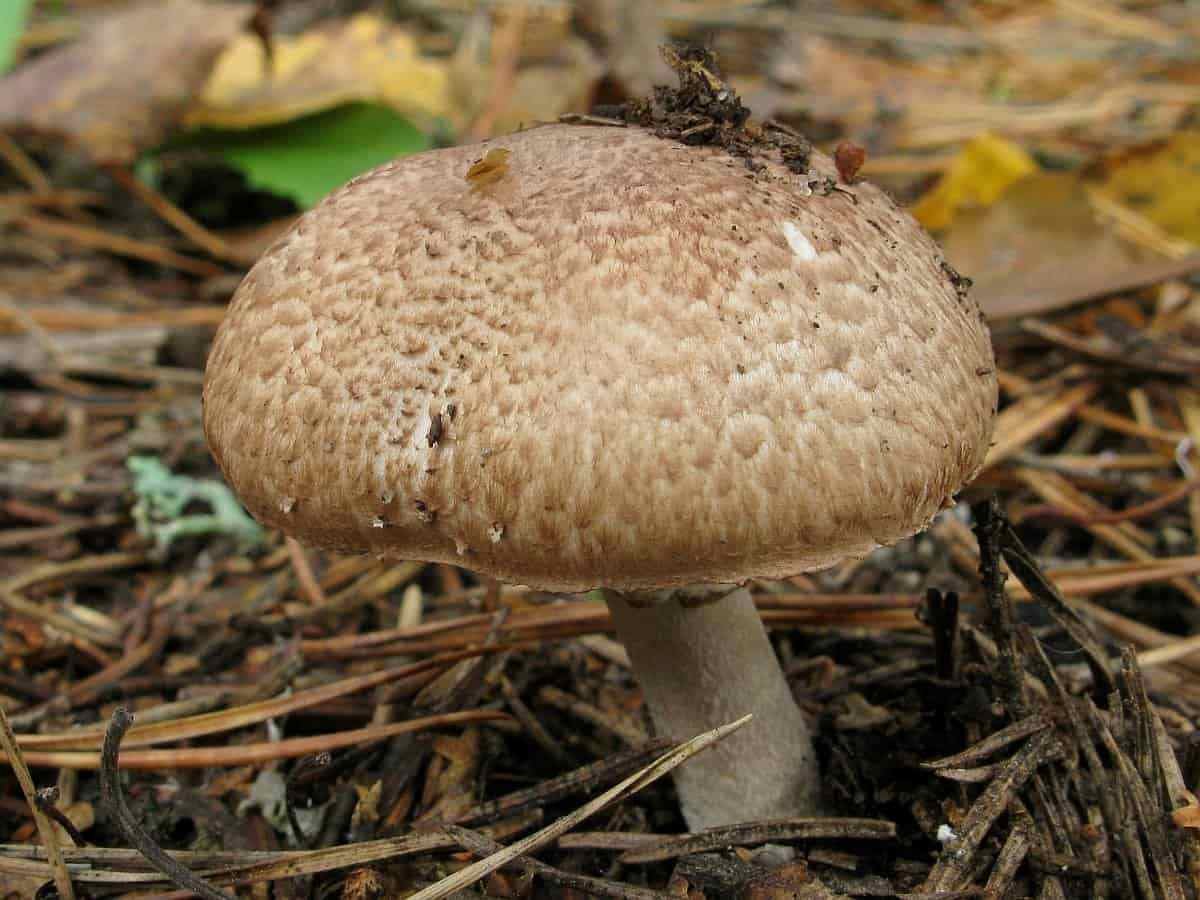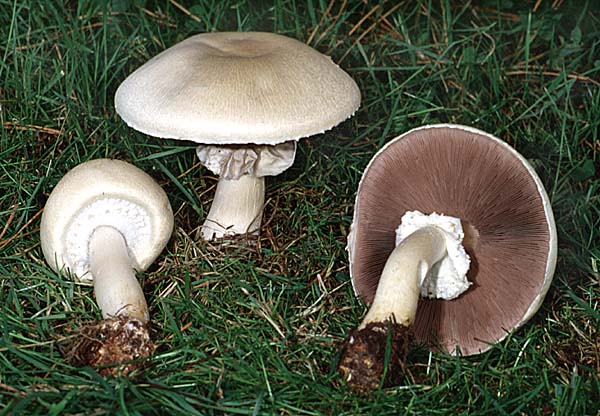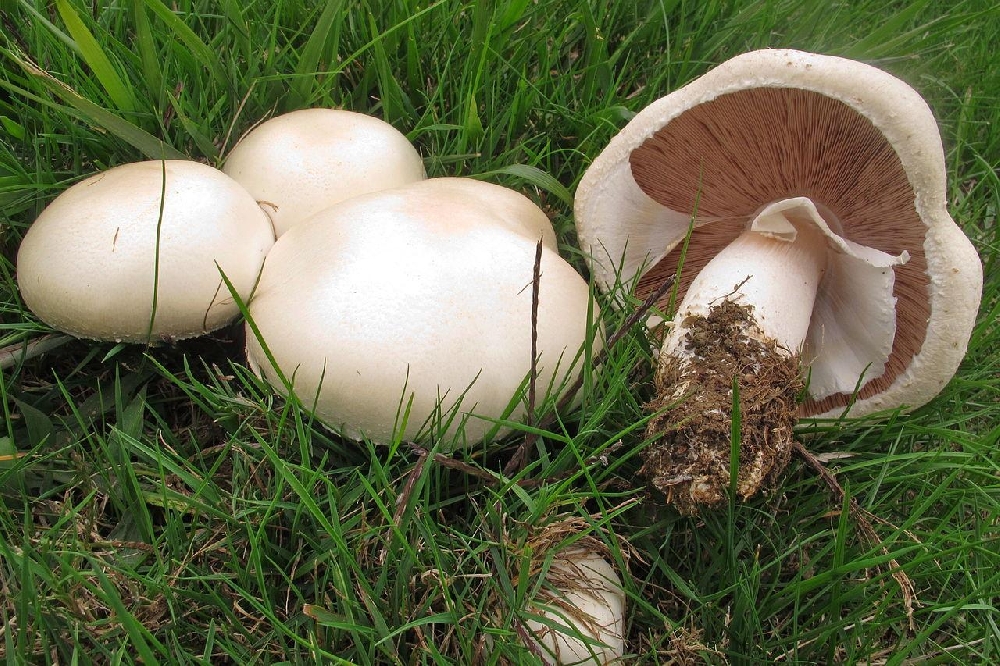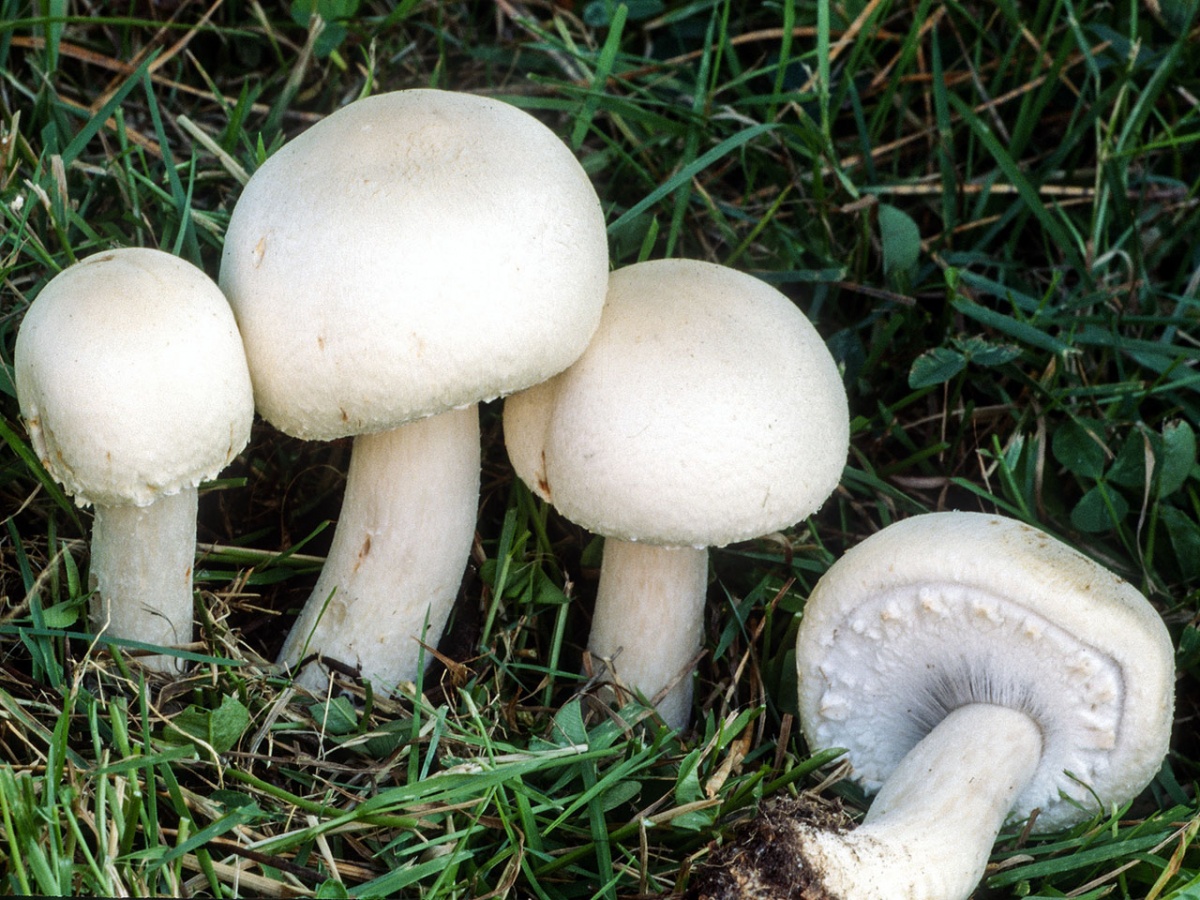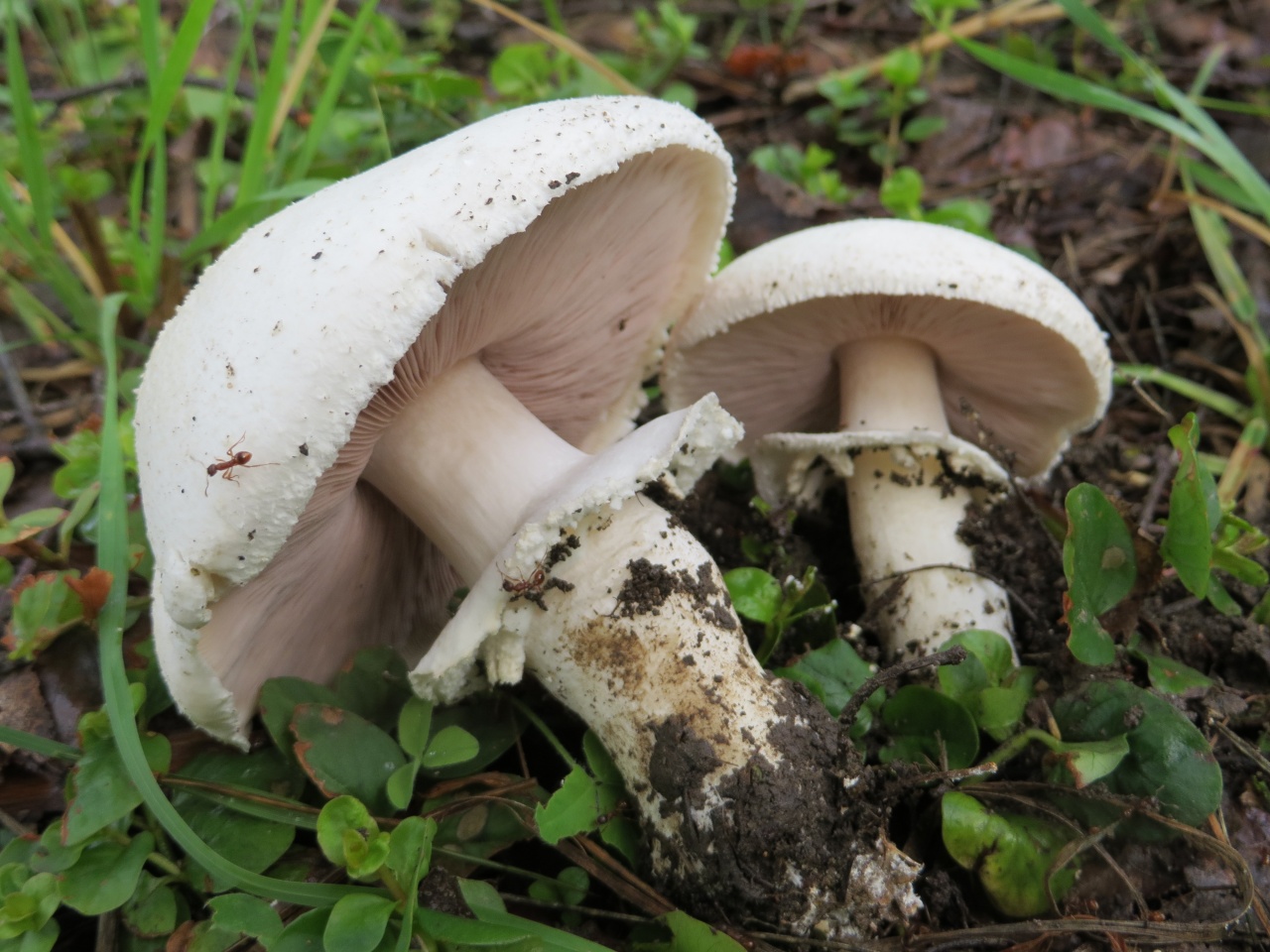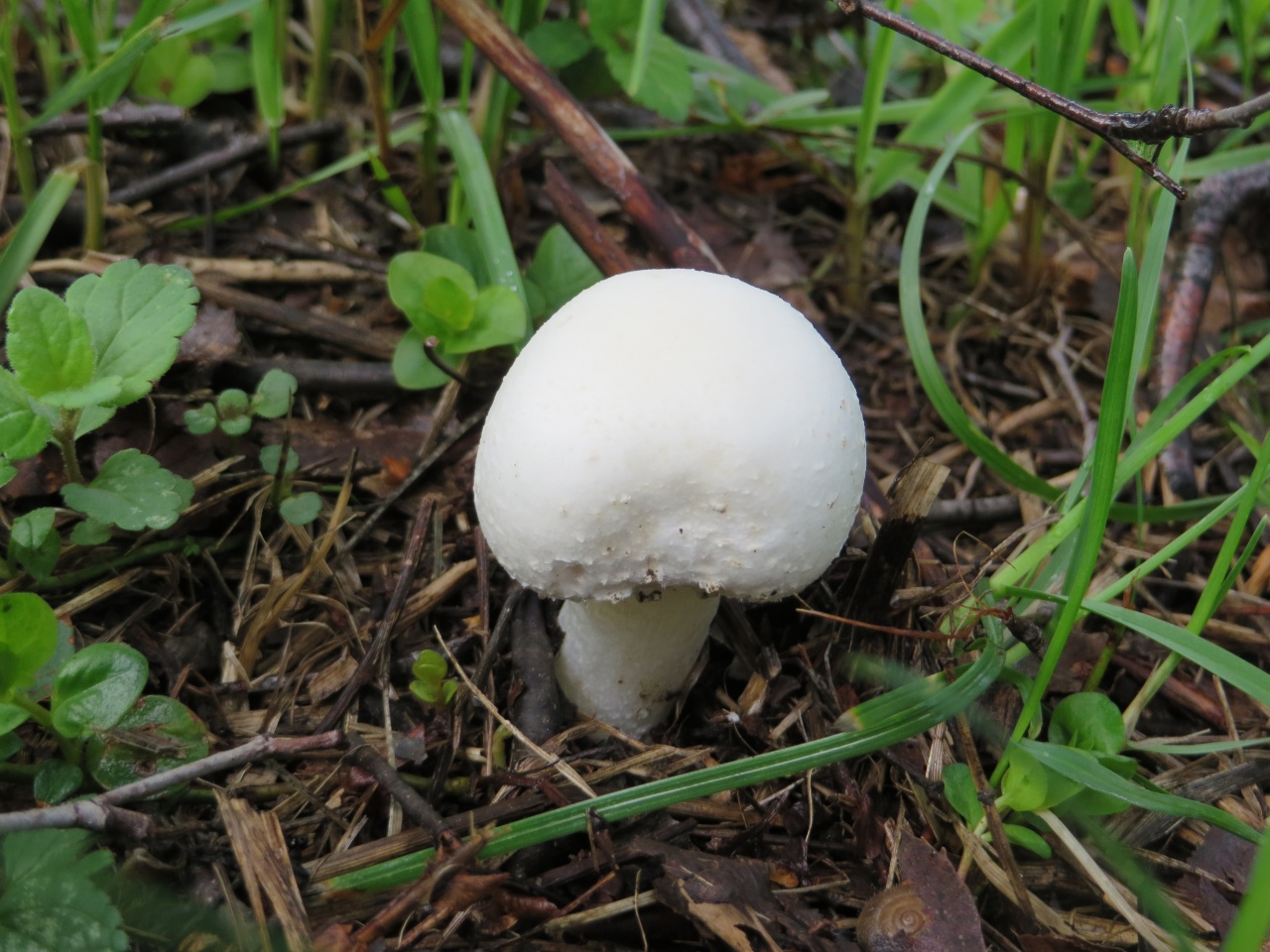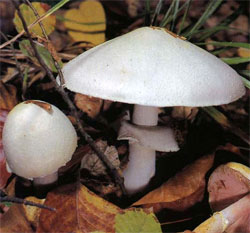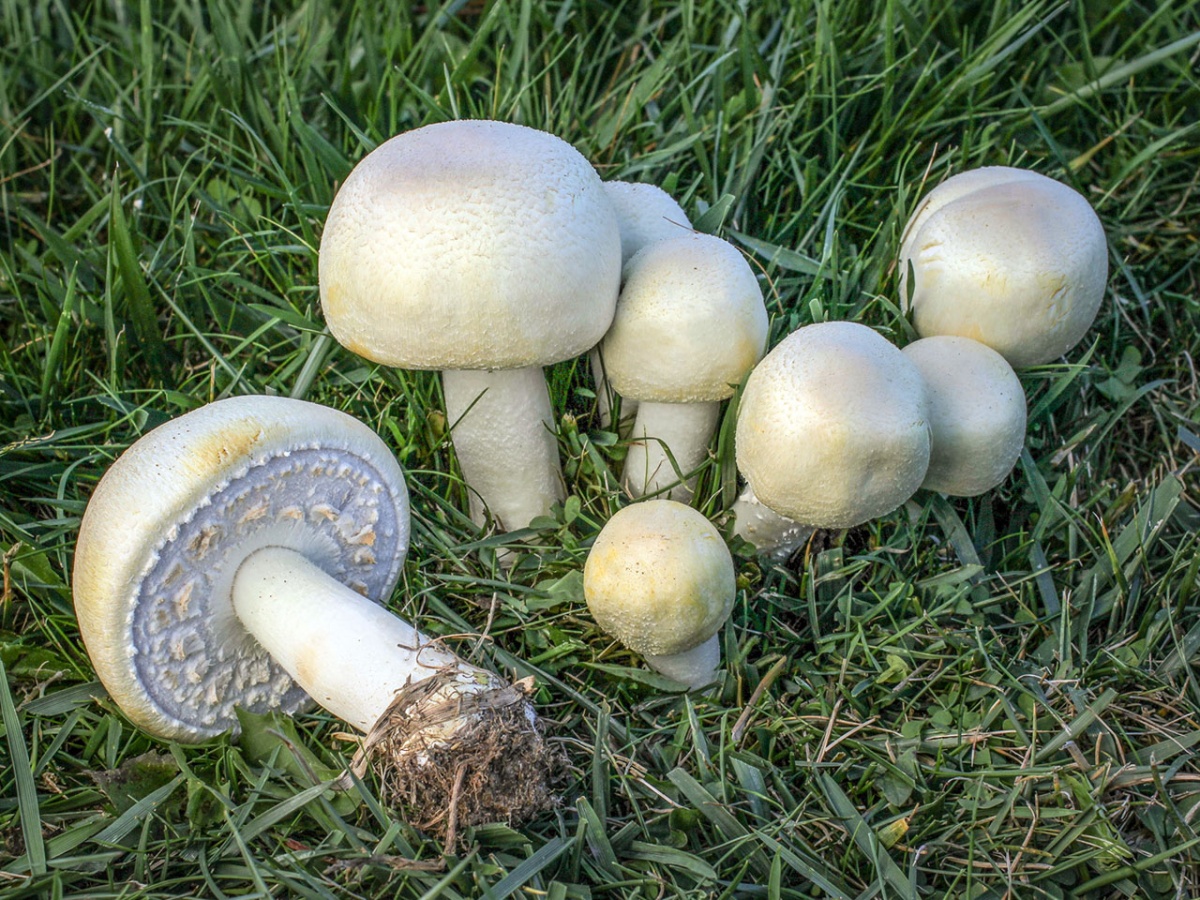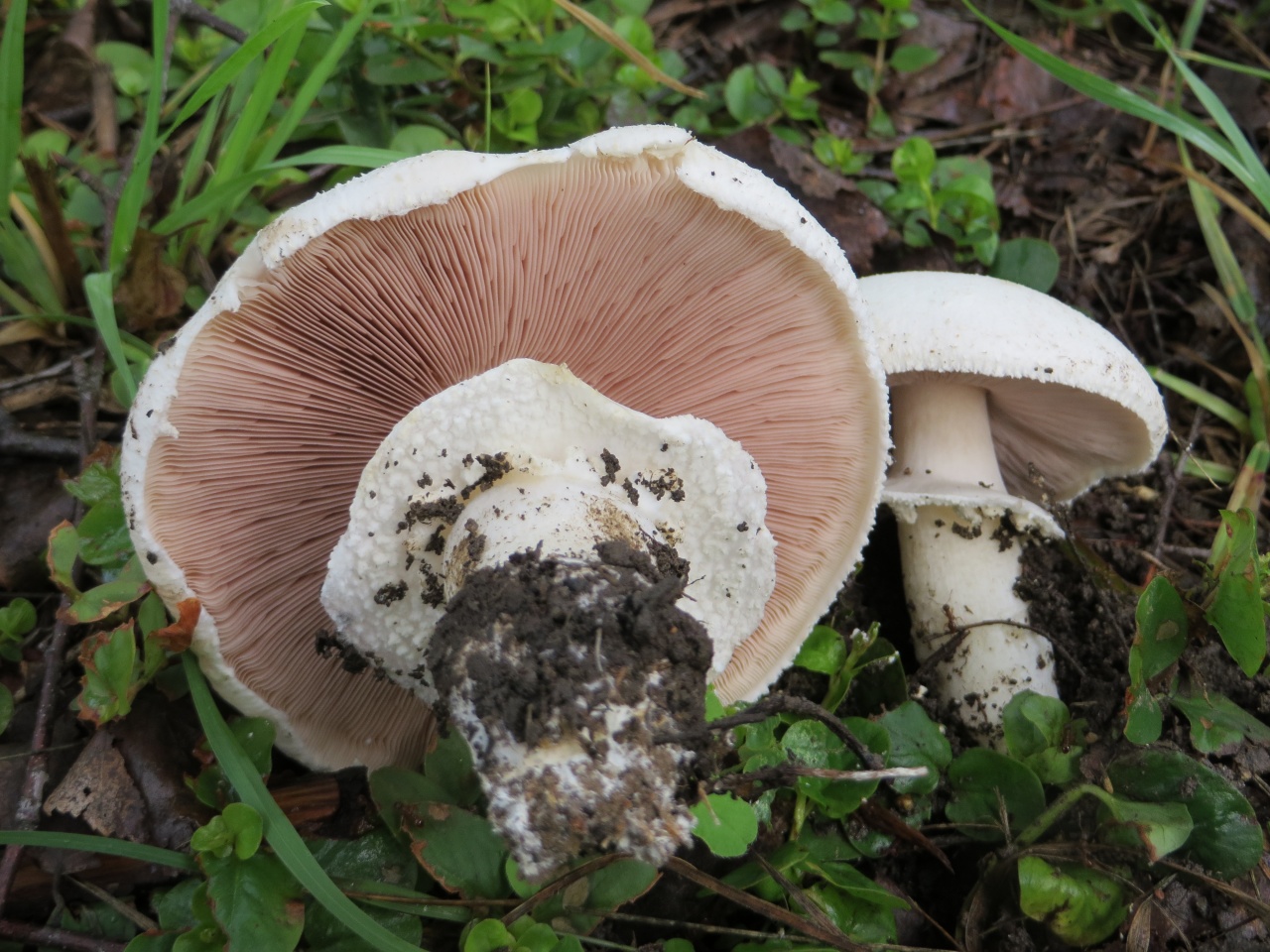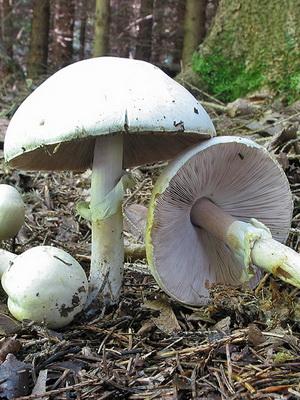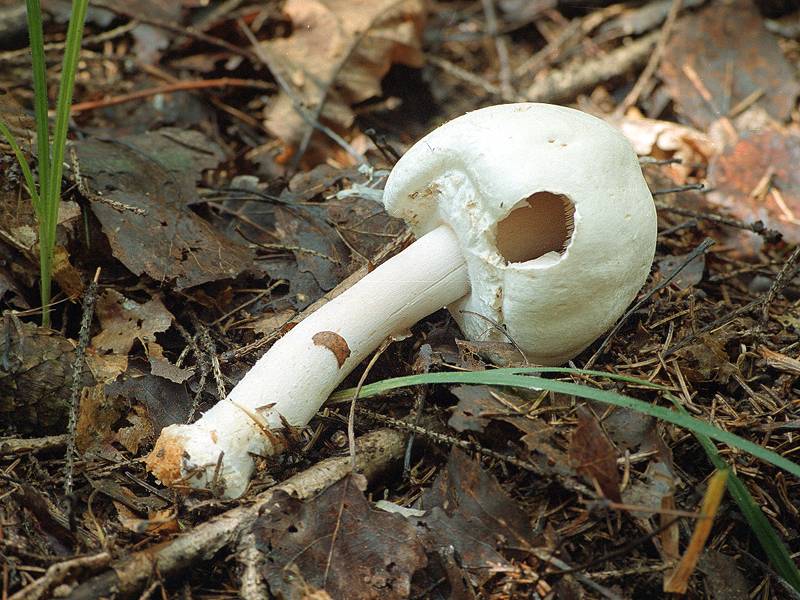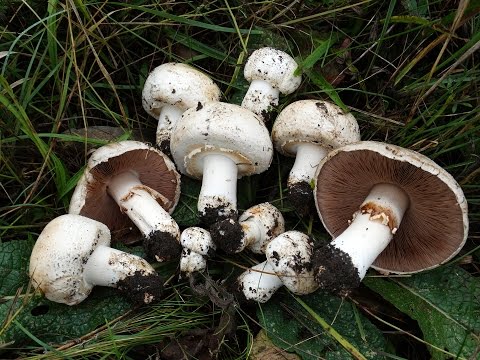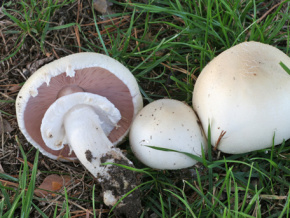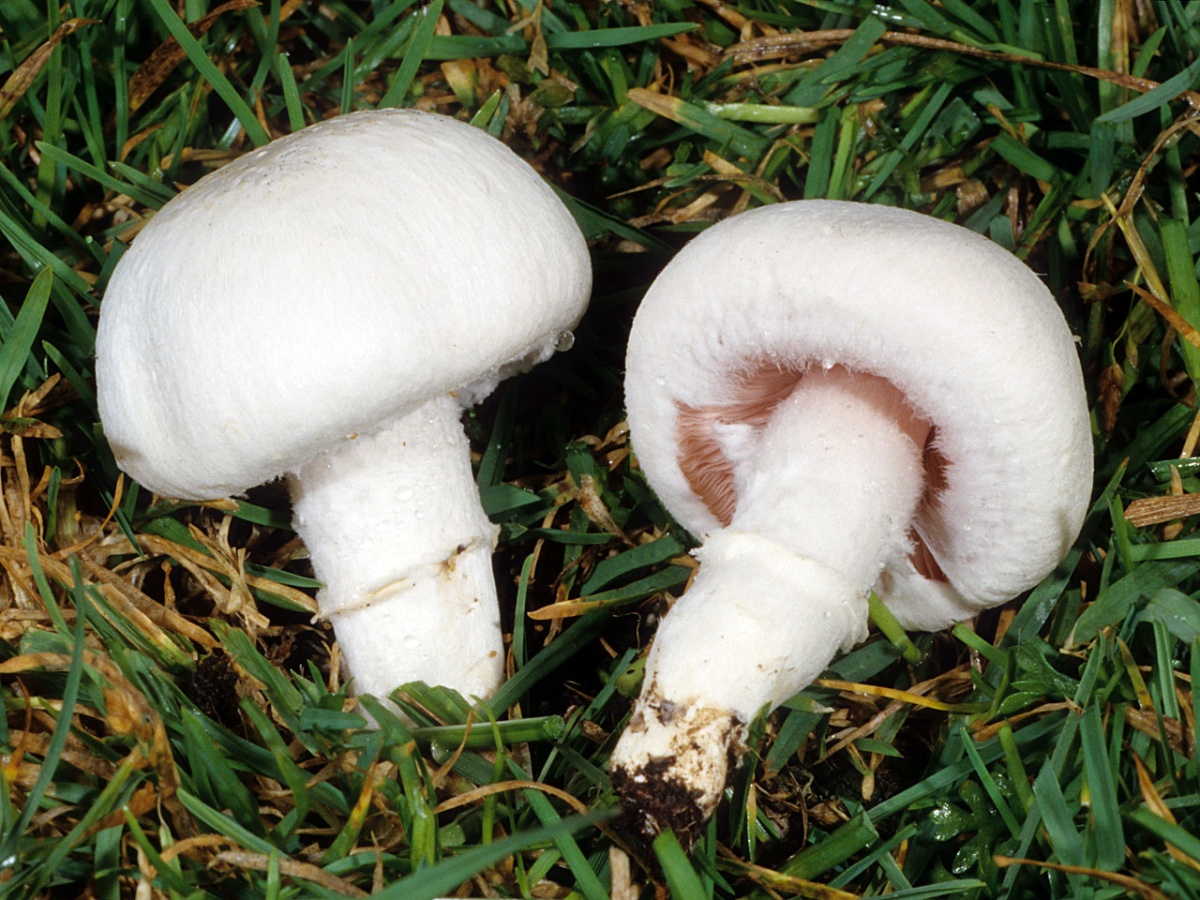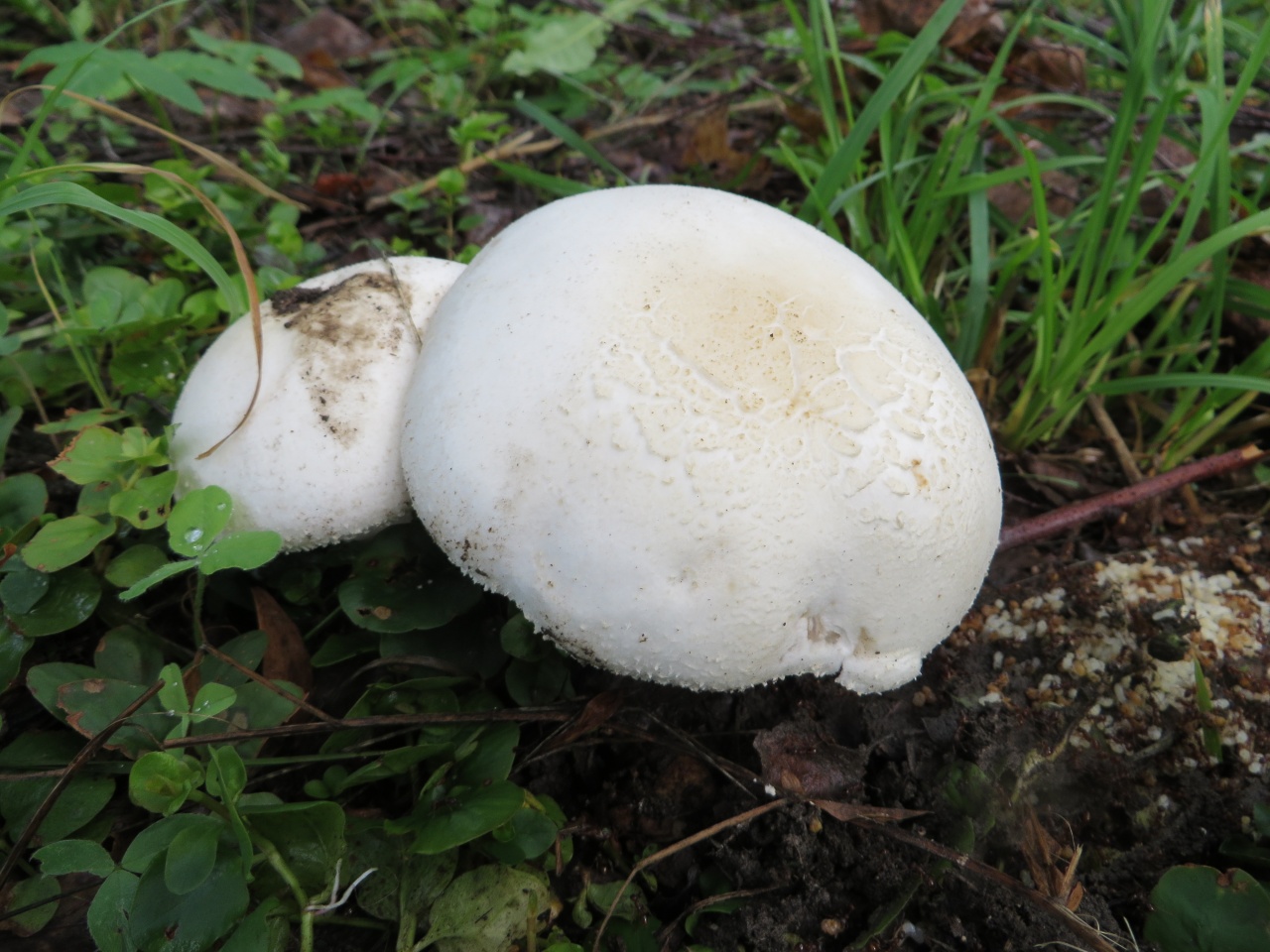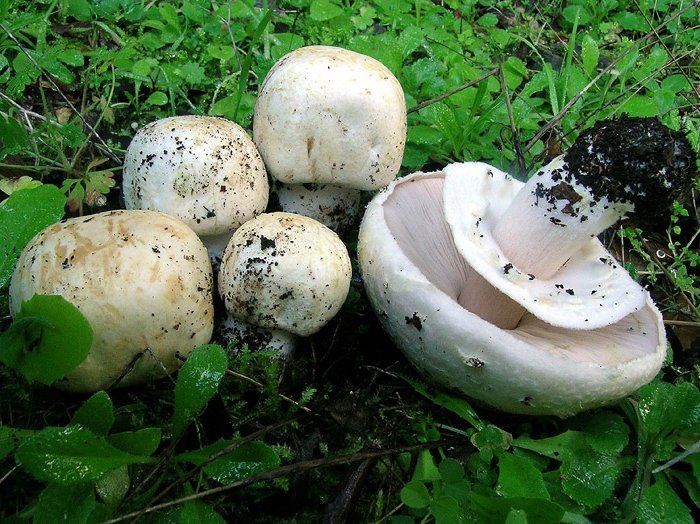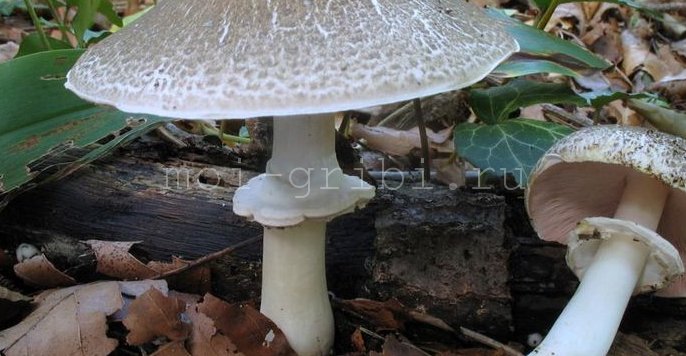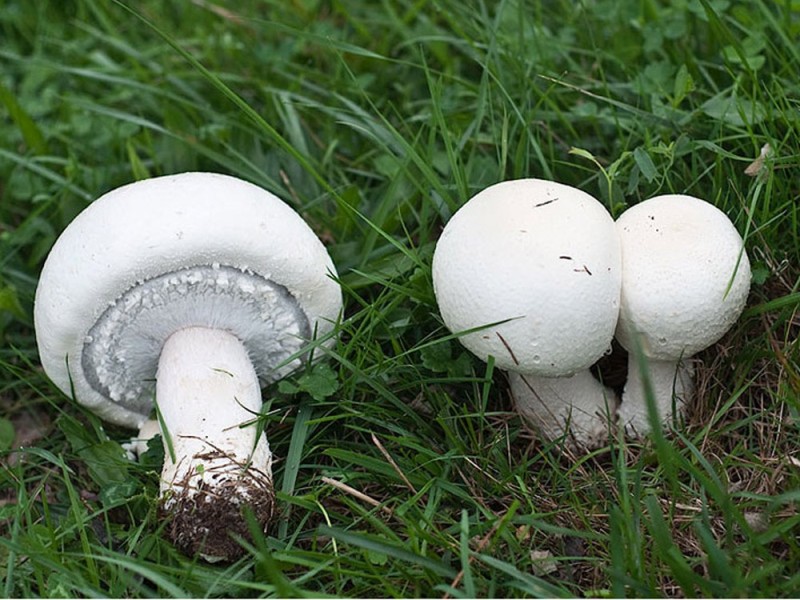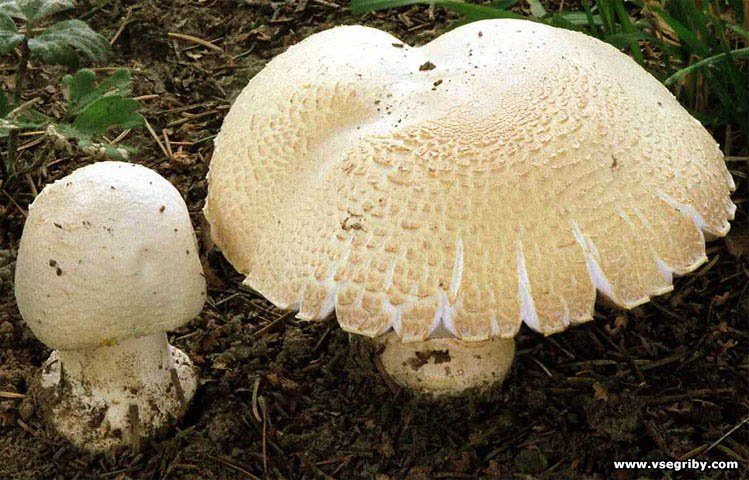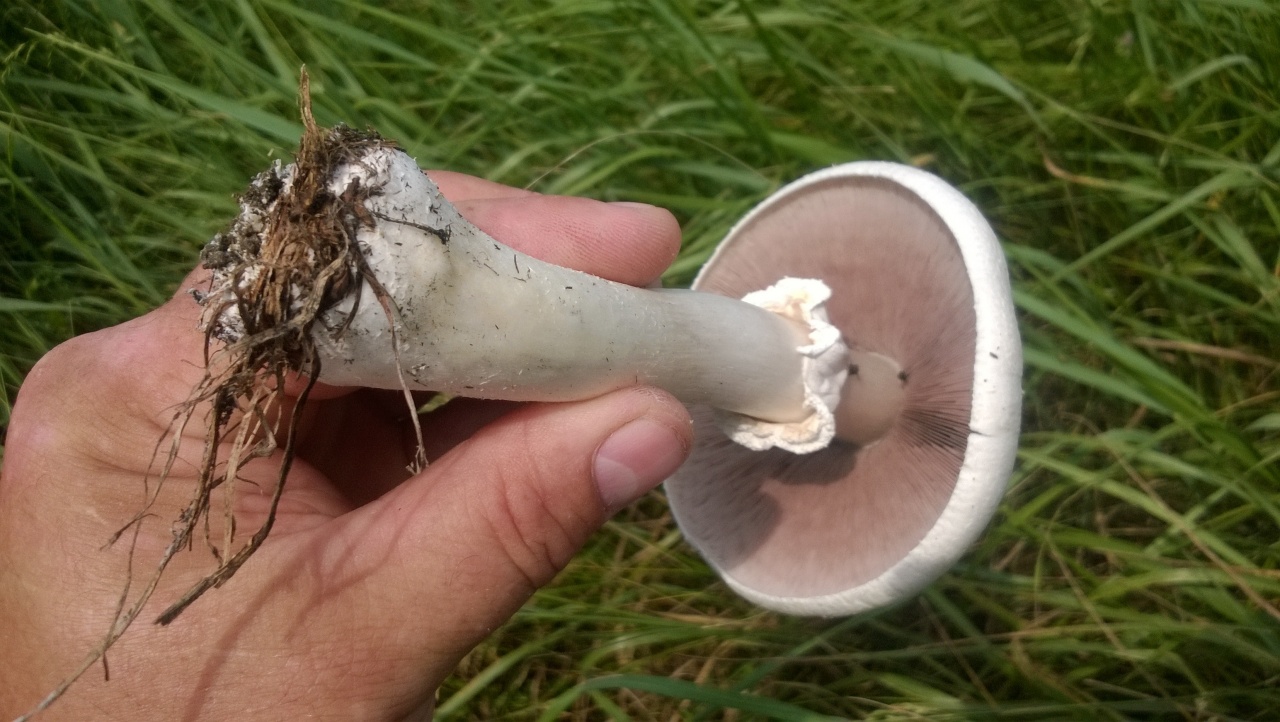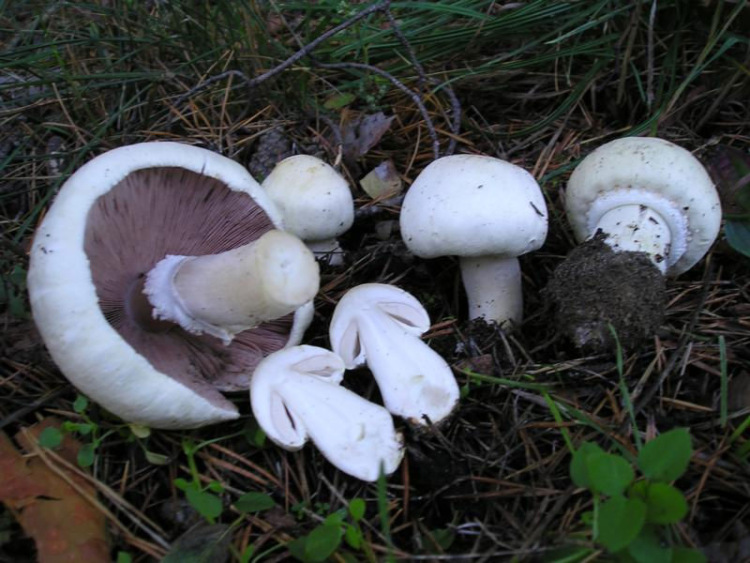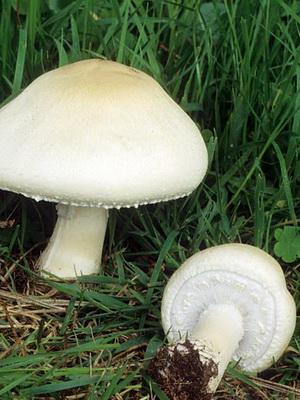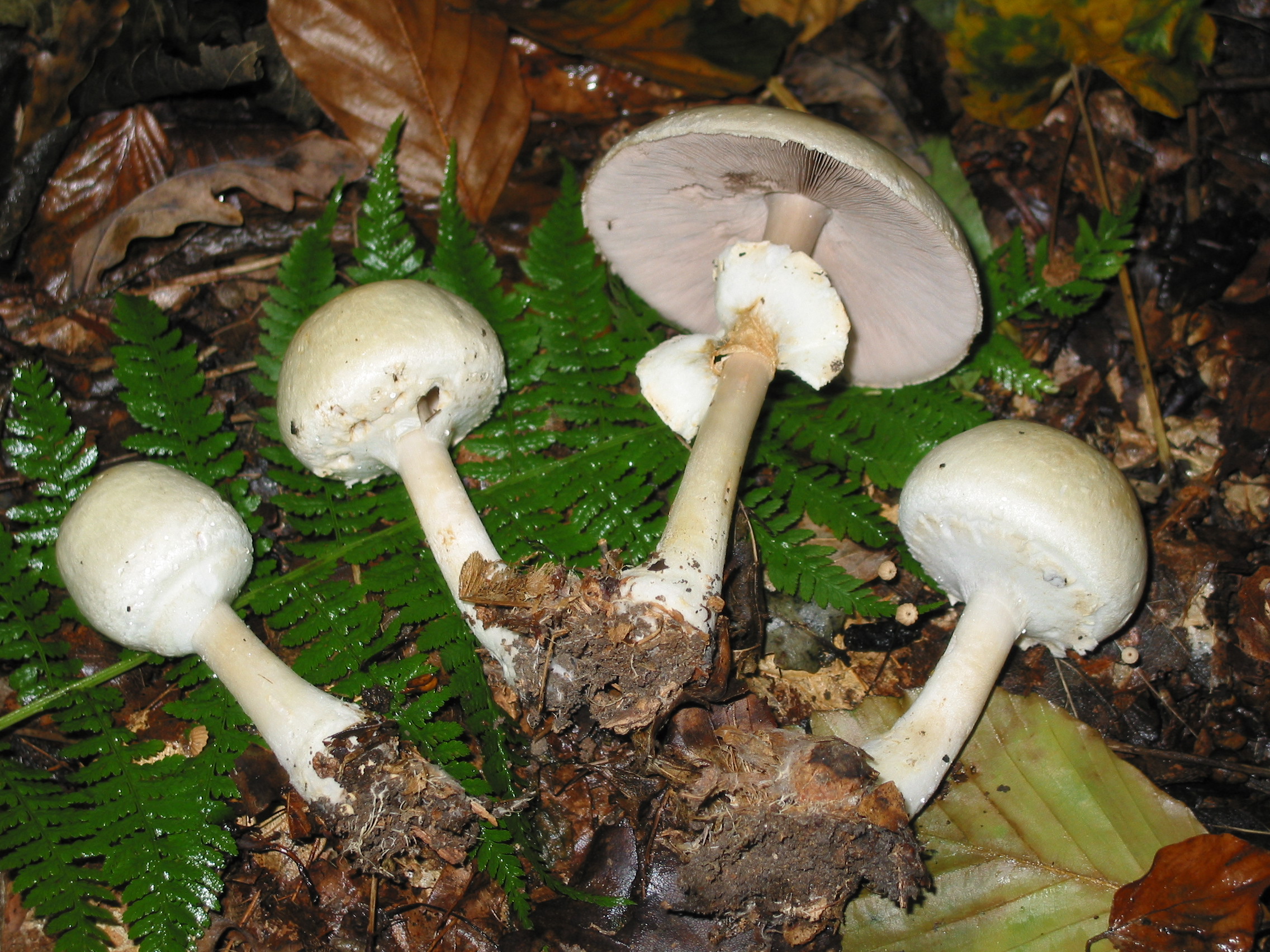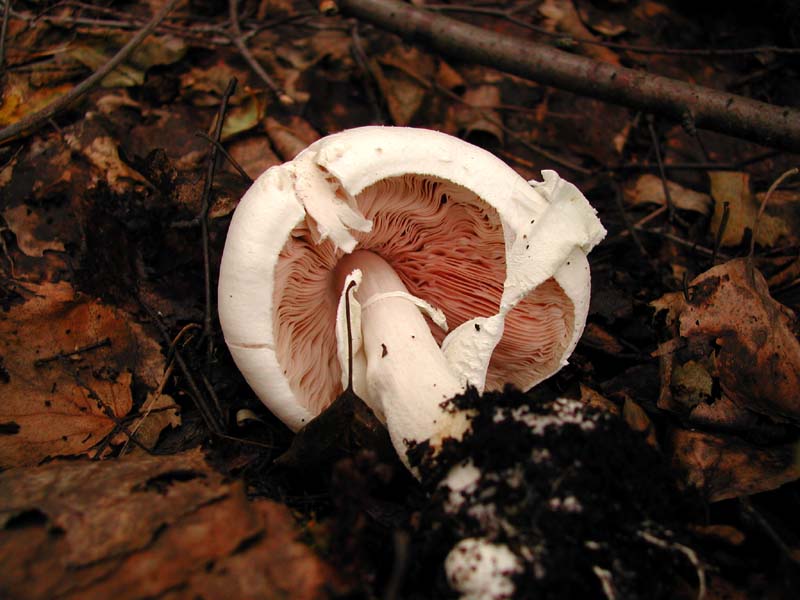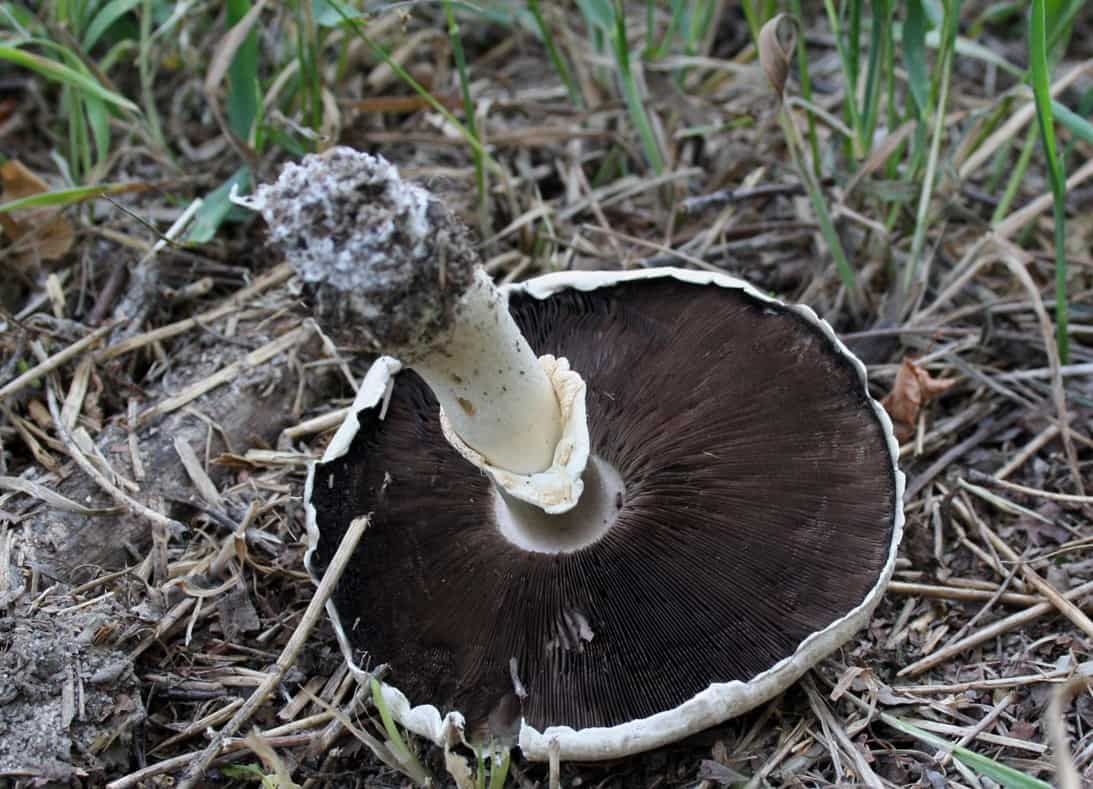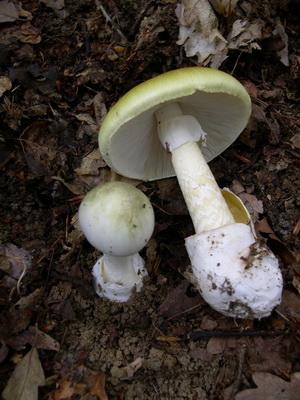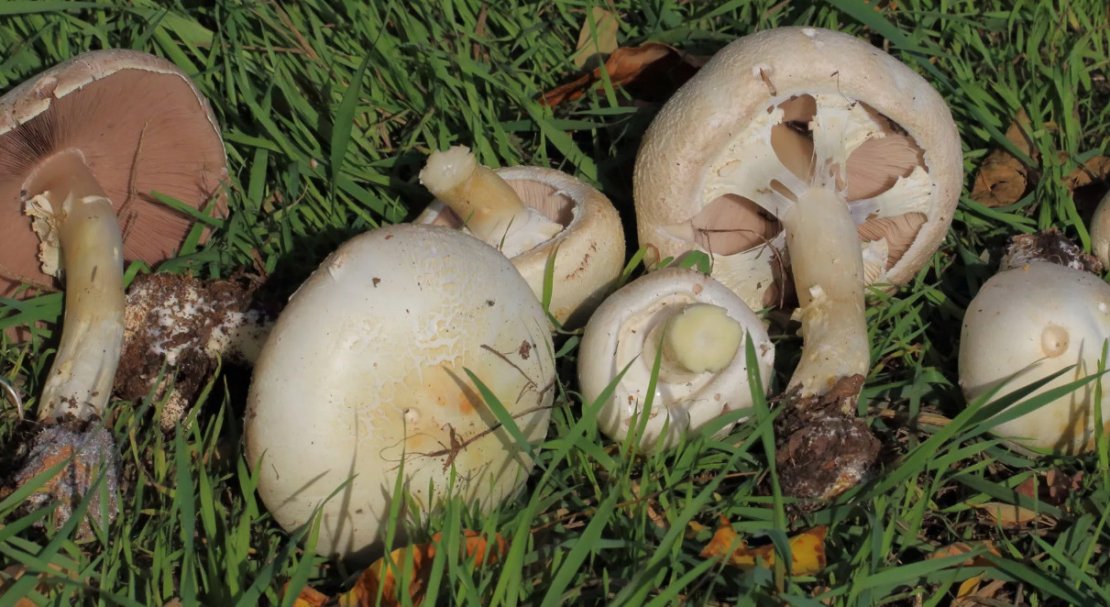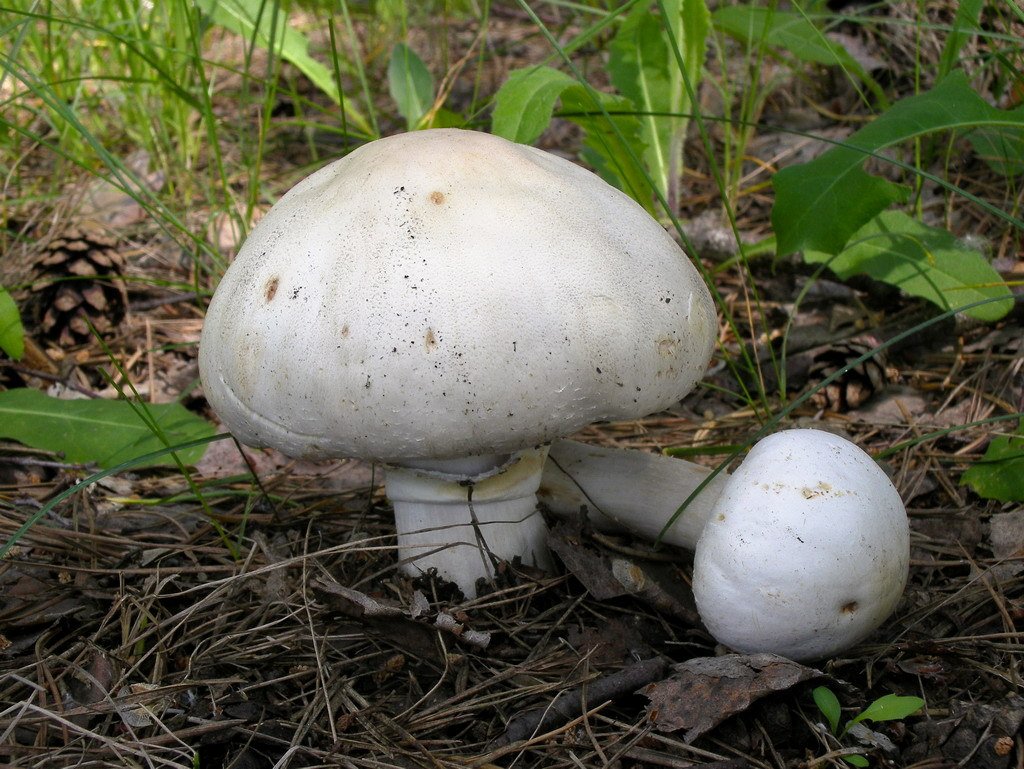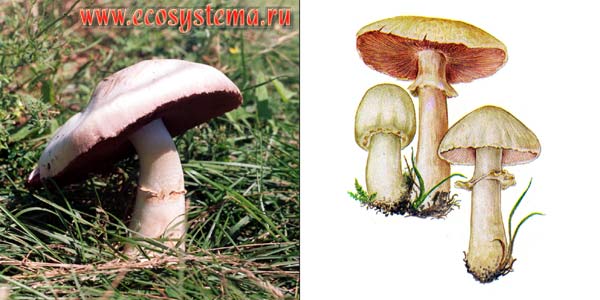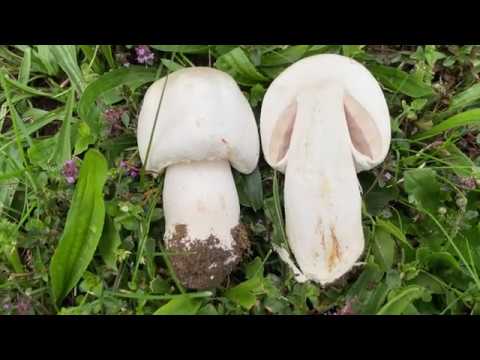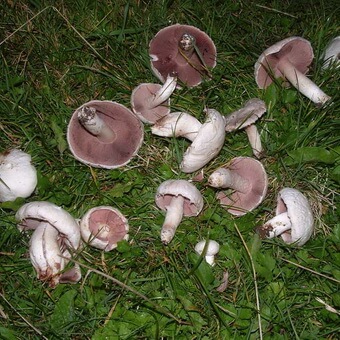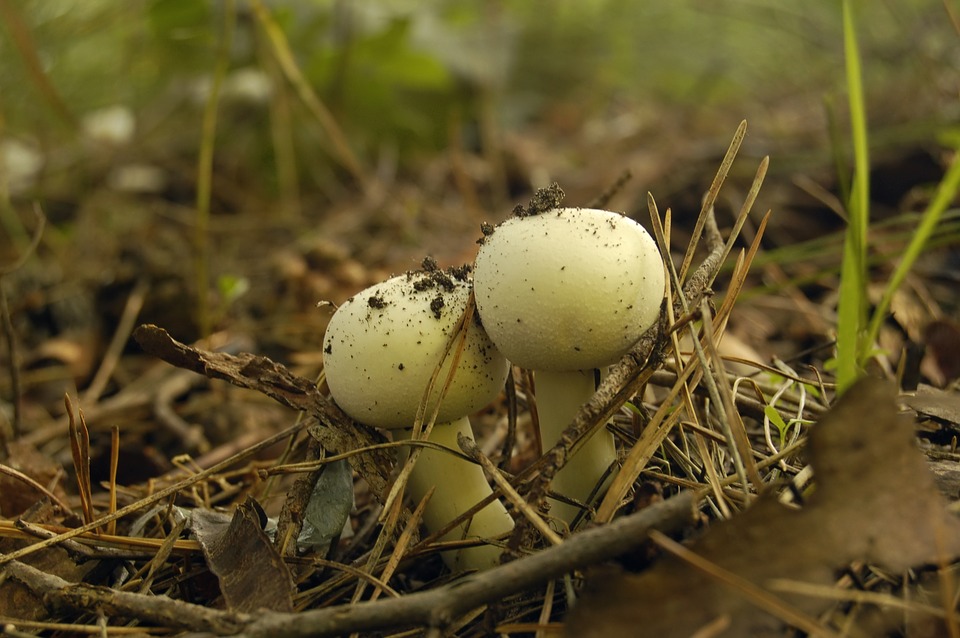Season and collection rules
In the conditions of a temperate climatic zone, the collection of the considered mushrooms can be started already from the end of May, continuing to search for them until October or even November. It is possible to determine the ripeness of the champignon optimal for harvesting by the film connecting its stem and cap: it is better to harvest when it is already well stretched, but has not yet had time to break (the diameter of the dome is 4–10 cm). Such specimens will be as fleshy and tasty as possible, which is what a mushroom picker needs.
Of course, it is better not to take damaged and unpleasant-smelling mushrooms, but healthy and evenly colored mushrooms can be carefully twisted out of the ground. Unlike most other forest mushrooms, you do not need to cut field mushrooms, which is due to the structural features of the plant mycelium. The holes remaining after them should be covered with a substrate, first removing all remnants of the previous harvest or remaining unusable specimens.
Did you know? Home cultivation of champignons in Europe began to be practiced back in the 17th century. Then it was considered a delicacy and was grown in underground premises that belonged mainly to monarchs. In Russia, this practice became relevant only in the 18th century.
Field champignon: description of appearance and photo
Category: edible.
In 1762, the field champignon (Agaricus arvensis) was singled out into a separate group by the professor of the Wittenberg and Tübingen Universities, Jacob Scheffer, a botanist, ornithologist and entomologist.
In appearance, the field mushroom is slightly different from other species. Hat (diameter 7-22 cm): white, gray, cream or light ocher (in old mushrooms) with remnants of the coverlet. It has the shape of a small egg or bell, but over time becomes almost prostrate with a noticeable tubercle in the center. The edges of young mushrooms are wrapped inward, and later become wavy. In dry weather, they can severely crack, due to which they become uneven and torn. Smooth to the touch, in rare cases it may have small scales. Stem (height 5-12 cm): usually the same color as the cap, turns yellow when pressed, fibrous, cylindrical and has a large double-layer ring. Often tapers from bottom to top. In young mushrooms, it is solid, but becomes hollow over time. Easily detaches from the cap.
Plates: can be white-gray, brownish, with a mustard or purple tint, in old mushrooms they are dark brown or black.
Flesh: white or light yellow, very firm, turns yellow on the cut and on contact with air. Tastes sweet.
The description and photo of the field mushroom are similar to the description and photo of the pale toadstool (Amanita phalloides) and the yellow-skinned mushroom (Agaricus xanthodermus).
However, pale toadstool does not have an aniseed scent and one-layer ring on the leg... And the yellow-skinned champignon has a strong medicinal smell of carbolic acid.
Field mushrooms grow from late May to early November in the northern regions of Russia.
Where it can be found: In open areas of forests, fields and pastures, it can be found in mountainous areas, nettle thickets or near fir trees. Large groups of field mushrooms sometimes form "witch's rings".
Eating: both fresh and after any kind of processing. A very tasty mushroom, in many countries it is considered a delicacy.
Application in traditional medicine (data have not been confirmed and have not undergone clinical trials!): In the form of an extract as an effective remedy in the treatment of diabetes mellitus. Broths have been used since ancient times in the outback as an antidote for snake bites.
Important! Field mushrooms often accumulate heavy metals. Cadmium, copper and other elements in high doses can be hazardous to health
Try to pick mushrooms in an ecologically clean area.
The British call the field mushroom horse mushroom, because it often grows on horse dung.
How to distinguish edible from inedible
An inexperienced lover of "quiet hunting" can easily confuse the field mushroom with poisonous, sometimes deadly, specimens:
- pale toadstool (Amanita phalloides);
- stinky fly agaric or white toadstool (Amanita virosa);
- spring toadstool or spring amanita (Amanita verna);
- fly agaric (Amanita citrina).
If you look closely, you will certainly find significant differences between these mushrooms - the poisonous specimen has a saccular thickening in the lower part of the leg - a volva, the plates of which do not change their shade and remain white, and the surface integuments do not turn yellow when cut or other damage.
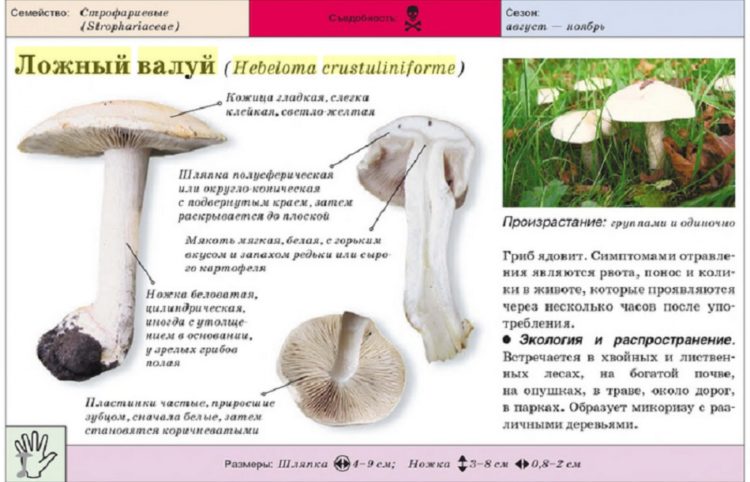
Due to inexperience, the field mushroom can be easily confused with a false value (Hebeloma crustuliniforme). The dangerous double has a pinkish or slightly yellowish hat, which darkens towards the central part, it also smells like horseradish, and not anise, like edible types of champignon.
It is also worth knowing that among the genus of champignons there is a similar poisonous species - yellow-skinned champignon (Agaricus xanthodermus). It is small in size and differs from the edible by its characteristic pharmacy odor. In addition, the main difference is the fact that its flesh turns yellow very quickly when cut.
Description of the appearance of the mushroom
Fake mushrooms differ depending on the age and where they grow. Most often there are mushrooms of a reddish tint, which are called yellow-skinned. The species of false champignons called "flathead" is also well known. It has a pungent unpleasant odor, reminiscent of iodine.
The color of the cap of the false champignon can be different. If the mushroom grows in a clearing well-lit by the sun, it will have a grayish tint. Organisms growing in forests are distinguished by a beige color with an orange tone. Young false champignon has white plates under the cap, which darken and turn black with age. They are easy to distinguish, because real mushrooms have a rough cap, sometimes covered with scales, while the double has a smooth skin.
The false champignon has a stem 10 cm high and 2.5 cm in diameter. It is cylindrical in shape, slightly thickened at the bottom. There is a white double ring in the middle. Under the cap there are thin frequent white plates with a pinkish tint. In older mushrooms, they become dark brown.
Differences between false and edible champignon
False mushrooms (poisonous) and real mushrooms are often confused, and this is deadly. The poisonous double of the champignon has a dark circle in the center of the cap; when pressed, yellowish spots appear. This verification method does not provide an exact guarantee, so it should be combined with other methods.
To find a false champignon among the real ones will turn out according to the following signs:
- its cut quickly takes on a bright yellow tint;
- the double has a pungent smell of disinfectant;
- when boiled, the water also turns yellow.
These are insidious mushrooms, even after a long cooking, poisonous substances in them do not disintegrate.
Inedible champignon is similar to the pale toadstool, white amanita, stinky amanita and meadow mushrooms. They have a similar color and shape of the cap, which sometimes resembles a chanterelle mushroom. False champignons most often appear in July in mixed and deciduous forests; they can also be found in clearings in city parks.
Field champignon

Russian synonyms: common champignon, sidewalk champignon. Known in English as the Horse Mushroom; perhaps due to the fact that this mushroom often grows near stables, on manured soil.
It is widely distributed and grows abundantly on soil, mainly in open spaces overgrown with grass - in meadows, forest glades, along roadsides, in clearings, in gardens and parks, less often in pastures. It is found both on the plain and in the mountains.Fruiting bodies appear singly, in groups or in large groups; often form arcs and rings. Often grows next to nettles. It is rare near trees; the exception is spruce. Distributed throughout Russia. Common in the northern temperate zone.
Season: from late May to mid-October-November.
The fruit body is large. The cap is thick-fleshed, at first rounded-bell-shaped, with a curled edge and with a private veil covering the plates, later convex-prostrate or prostrate, with a small wide tubercle or slightly flattened in the center, sometimes with a wavy edge and with remnants of a veil along the edge; 8-20 cm in diameter; white or cream, with age - with an ocher tinge, slowly yellowing from touch; silky, smooth or covered with fibrous yellowish or brownish scales; in dry weather, it often cracks along the edge.
The pulp is dense, with age it is softer, white or yellowish (in mature mushrooms), sweetish. At the break, the pulp turns slightly yellow. Has a characteristic smell of anise or almonds (especially in young mushrooms).
Plates are frequent, swollen, wider towards the periphery, free at the stem, 8-12 mm wide, first white, grayish-whitish, later grayish-brownish, then mustard, brown-violet, brown-chocolate or almost black.
Stem 6-10 cm high, 1-1.5 cm wide, cylindrical, smooth, widened or thickened towards the base; with a large wide white two-layer ring in the upper third of the leg (the lower ring is shorter, with a yellowish edge, toothed); fibrous, solid in young mushrooms, later - with a narrow cavity (fistular), easily separates from the cap, with a flocculent coating at the base; the same color as the cap, turns yellow when pressed. The pulp at the base of the leg does not acquire a yellow tint.
Spore powder is black-brown. Spores 7-9 x 4.5-6 µm, ovate-ellipsoid, smooth, brown. Cheilocystids are thin-walled, ovoid, 11-26 x 9-18 (21) µm.
Color chemical reactions: the pulp gives a yellow color with potassium hydroxide.
Similar species
Poisonous species:
- Amanita phalloides. It is distinguished by white plates of the hymenophore, a tuberous-swollen base of the leg surrounded by a volva, a white single-layer ring on the leg and the absence of the characteristic smell of anise.
- Yellow-skinned champignon (Agaricus xanthodermus). Smaller type of champignon; occurs frequently, especially in white acacia plantings, from July to October. Differs in an unpleasant ("pharmacy") smell of carbolic acid. When broken, especially along the edge of the cap and at the base of the leg, its flesh quickly turns yellow.
Edible related species: Similar to many other mushroom species (Agaricus silvicola, Agaricus campestris, Agaricus osecanus, etc.), differing mainly in larger sizes. Most similar to it is the curve champignon (Agaricus abruptibulbus), which, however, grows in spruce forests, and not in open and light places.
Food quality: Edible. Delicious, gourmet mushroom (3 categories), according to its taste - one of the best mushrooms. Edible even raw. It is used in a variety of ways - fresh (after 10 minutes of boiling), salted, pickled. However, it is capable of accumulating cadmium, copper and other heavy metals, which can be potentially hazardous to health.
Field champignon
| Group: | Lamellar |
|---|---|
| Plates: | White, gray, pink, brown |
| Colour: | White |
| Info: | Anise aroma with almonds at the pulp |
| Department: | Basidiomycetes (Basidiomycota) |
|---|---|
| Subdivision: | Agaricomycetes (Agaricomycotina) |
| Class: | Agaricomycetes |
| Subclass: | Agaricomycetidae (Agaricomycetidae) |
| Order: | Agaric, or Lamellar (Agaricales) |
| Family: | Champignon (Agaricaceae) |
| Genus: | Champion (Agaricus) |
| View: | Field champignon (Agaricus arvensis) |
Description of appearance
This is a rather large white mushroom with a wide umbrella-shaped cap, a straight stem and a characteristic ring (remnants of a mushroom blanket).
In diameter it reaches from 5 to 15 cm, in young representatives it is hemispherical, at first it covers the leg. With age, it begins to bloom and, as a result, becomes like an open umbrella. By old age, the edges begin to sag, which is why it droops.
On the reverse side are the plates, which at first have white and gray shades, then turn pink and finally turn brown. The pulp has a firm consistency, although it softens with age. Painted in white or yellowish shades, sweetish in taste. Smells good (anise with almonds aroma).
Leg

A characteristic feature is the presence of a two-layer ring. The color of the leg is exactly the same as the hat. It also turns slightly yellow when pressed, but the lower part remains light even after the cut.
Mushroom spread
The name of the species is given due to the fact that it mainly prefers open places:
- Gardens and parks
- Roadsides
- Sometimes pastures
It can grow not only on the plains, but also in the foothills. It is found everywhere within the temperate climatic zone. It grows mainly in fields, not forests.

Similar species
Both edible and poisonous species are similar to it.
Among the latter, it is important to learn to distinguish between:
Which has white, pale plates. Another sign is that the leg expands to the lower edge, and a blanket (volva) is located around it. Plus, the toadstool doesn't smell like almonds or anise.
It is smaller, mainly grows in acacia bushes. A characteristic feature is the smell of carbolic acid, which can be described as "medical" or "pharmacy". If you cut or break the flesh, it will quickly turn yellow.

Field champignon is similar to edible representatives of the same family, but differs from them in a larger fruiting body. For example, it is similar to the curve champignon, which is mainly found in coniferous forests, including under spruce trees, and not in open fields.
Edibility
The mushroom belongs to delicacies, category 3 edibility. It is suitable for preparing first and second courses. In addition, the field champignon can be salted and pickled. However, it can only be collected in ecologically clean places.
Interesting Facts

Despite the fact that the field champignon grows in open places, it can be found in light deciduous and even coniferous forests. It is able to form mycorrhiza with any trees, but it never forms a root with spruces. It is also interesting that the mushroom has adapted quite well to climatic conditions, since it can be found not only in summer, but also in late autumn - until November.
The mushroom is a gourmet variety and is suitable for almost any traditional dish. However, it can be consumed fresh after a short boil (10 minutes in boiling water). Has an interesting sweetish taste, not like the classic aroma of champignons.
What false champignons look like: photo and description of the appearance of mushrooms
Most often, such representatives of the Agaric family are taken for edible specimens:
- Agaricus xanthodermus.
- Agaricus meleagris.
- Agaricus californicus.
Typical examples of false champignons are shown in the photo.
A number of features will help to distinguish such specimens from edible ones. On the cap, the poisonous twin has a speck of brown color, which is located in the center. If you press on it, light yellow spots will appear. But this method is not guaranteed, so it is better to use it in tandem with other traits.
When broken, the pulp of false forest and field mushrooms begins to turn yellow and smells unpleasant with carbolic acid, and during cooking, the water and the mushrooms themselves turn bright yellow for a short time, but this color quickly disappears. Long-term heat treatment will not be able to rid the product of toxins.
Take a look at the photo and study the description of the appearance of false forest mushrooms.
The color of the cap and its shape can change under the influence of the environment, therefore, special attention is paid to the pulp, its smell, shade and changes during cooking.Another mushroom that disguises itself as an edible is a pale toadstool.
Outwardly, it resembles a champignon, while it does not have a smell by which it could be recognized. There are volves (root sacs) at the base of the toadstool, but people don't always notice them. If you have the slightest doubt about the suitability of the mushroom, you should break the pulp and see if it turns yellow, and then check the color change of the water during cooking. This is one of the most accurate and proven ways to distinguish real edible champignons from false ones.
Another mushroom that disguises itself as an edible is a pale toadstool. Outwardly, it resembles a champignon, while it does not have a smell by which it could be recognized. There are volves (root sacs) at the base of the toadstool, but people don't always notice them. If you have the slightest doubt about the suitability of the mushroom, you should break the pulp and see if it turns yellow, and then check the color change of the water during cooking. This is one of the most accurate and proven ways to distinguish real edible mushrooms from false ones.
You can only confuse the "young" pale toadstool: over time, bulges will appear on its hat, it will become smooth, and the fringe will become saggy. Toadstool appears from the first half of June, its growth peak falls in August. The height of the toadstool can reach 20-25 cm, and the diameter of the cap does not exceed 15 cm.
Inexperienced mushroom pickers can mistake one of the light amanitas for good mushrooms. In this case, the unpleasant smell that the pulp has will save from poisoning.
If you don't know what poisonous false mushrooms look like, take a look at the photo: these are common mushrooms that are often mistaken for edible ones.
Types of mushrooms, appearance
Description
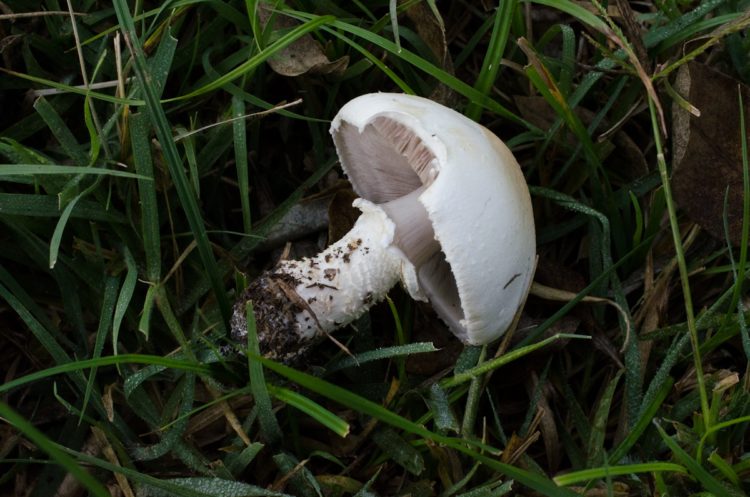
- Field mushrooms, photos of which from different angles are presented below, have a rather large fruit body with a pronounced stem and cap.
- The diameter of the cap varies around 15 cm and in some cases reaches 20 cm. The upper part of young specimens is painted in a light cream color, and as the mushroom ages, its cap acquires a brownish tint. The shape of the cap remains closed for a long time, hemispherical, with edges bent inward, and in overripe mushrooms it straightens and becomes drooping. The surface of the cap of the field mushroom is covered with small scales, which crack and turn yellow over time.
- On the inside of the cap there is a white film covering the curved thinnest plates. Initially, they are colored light gray, but gradually turn pink, and at the end of the fruiting stage they acquire a deep brown hue.
- The pulp of the mushroom is dense and fleshy, of a snow-white shade. However, when cut, it quickly turns yellow and smells like anise.
- The stem of this type of champignon reaches a height of 10 cm and a width of 2 cm. It has a cylindrical shape and expands at the base. Young specimens have a dense, solid leg, however, as the fungus ages, it becomes hollow. The color of the leg matches the color of the cap.
- On the lower part of the field specimen, two rings can be seen: the upper one is wide, two-layered, white, and the lower one is serrated, short, yellow. It is this feature that will allow you to distinguish the field mushroom from other champignon varieties.
- This mushroom has a unique rich aroma. Its scent clearly contains subtle hints of almonds, a light hint of anise and a slight spice of nutmeg.
- Field champignon spores are smooth, brown and elliptical.
Did you know? Field champignon (Agaricus arvensis) is the largest representative of lamellar mushrooms from the Champignon family. People often call it sidewalk champignon or common champignon. In England, the name Horse Mushroom was stuck with it, which in translation into Russian means "horse mushroom" - perhaps this is due to the fact that this champignon mushroom in most cases can be found near the stables, on manured soil.
Similar species

The field champignon has several counterparts: as a rule, these are other varieties of this kind of mushrooms:
- curve (Agaricus abruptibulbus);
- meadow (Agaricus campestris);
- coppice (Agaricus silvicola).
The main difference between the field specimen and its relatives is its larger size and place of growth. For example, meadow varieties prefer to settle in meadows or be placed in a field, while crooked champignons hide from the sun and grow exclusively in forests. Coppice mushrooms, like curves, do not like open spaces. All of the listed varieties are edible and similar to each other.
Similar species and how to distinguish from them
Thin champignon is most similar to its relatives from the mushroom genus:
- edible curves (Agaricus abruptibulbus) with a noticeable difference - an expanded nodule at the base of the leg;
- edible field (Agaricus arvensis) - larger, growing in meadows, glades, forest edges, garden plots, along roadsides and in parks;
- poisonous yellow (Agaricus xanthodermus). It can be recognized by its phenolic odor, which is pungent and unpleasant.
In addition, young coppice mushrooms with not yet darkened blades bear a certain resemblance to the deadly pale toadstool (Amanita phalloides) and the no less toxic stinking fly agaric (Amanita virosa). The main distinguishing features of these poisonous mushrooms are white plates at any stage of growth, a cap that does not turn yellow when pressed, and a volva that covers the widened bottom of the stem.
Treatment for poisoning
After hospitalization, the patient is detoxified. This is an enema, gastric lavage or hemodialysis. The choice of the method of treatment depends on how much of the dangerous product the patient has eaten.
Later, the patient is restored to the water-electrolyte balance or put on a dropper. The victim must also adhere to a special diet:
- stop eating fatty, spicy and smoked foods;
- eat only boiled food;
- finely chop vegetables and fruits.
Providing first aid, you can not induce vomiting in children under 3 years of age and women in position. Also, do not give enemas to people of age without the help of a doctor. The victim is prohibited from taking drugs that fix the stomach
This is especially important when poisoning with dangerous mushrooms such as pale toadstool.
How to distinguish the false edible counterparts of a poisonous mushroom?
Outwardly, it is similar to its edible "counterparts": common mushroom, meadow and maroon mushroom, only differs from them in the characteristic unpleasant odor of carbolic acid. The table shows the main characteristics of these types of mushrooms.
| Double view | Hat | LPs | Pulp | Leg | Leg ring | Smell | Places of fruiting |
Champignon common or meadow (A. campestris) |
6-15 cm in diameter, thick, white, sometimes brownish, dry, silky, or with small scales | White, pinkish, dark brown with a purple tint when ripe | White, thick, turns red at the break. Typical mushroom taste | 5-9 cm long, 1-3 cm thick, straight, swollen at the base, cap color | Filmy, wide, white, in the middle of the leg | Pleasant mushroom | On humus-rich soils: in gardens, vegetable gardens, parks, meadows, on the territory of livestock farms |
Field champignon (A. arvensis)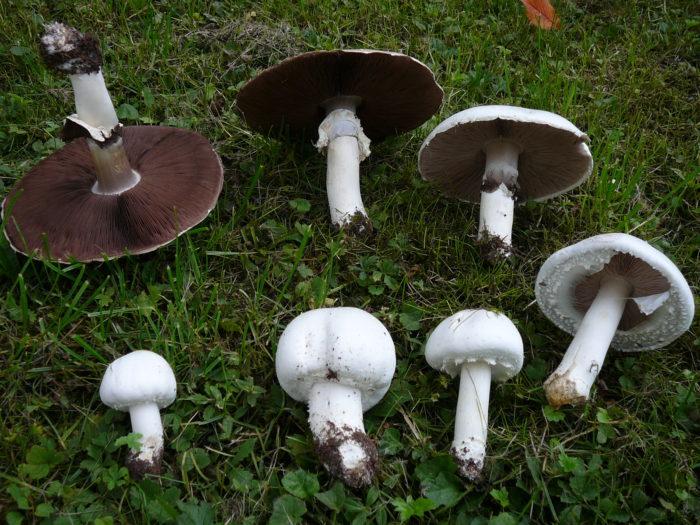 |
8–20 cm in diameter, thick, fleshy, white or creamy, with age - ocher hue, smooth, slowly turns yellow when touched | Frequent, widened towards the edges, the color changes from white to mustard, brown-purple, chocolate and almost black | Dense, becomes softer with age, light, easily separates from the cap, pale yellow at the break. It tastes sweet | 6-10 cm long, 1-1.5 cm thick, smooth, straight, thickened at the base, cap color | Large, wide, two-layered, located in the upper third of the leg | Pronounced aniseed or almond | On the soils of open spaces: in meadows, forest glades, in parks, gardens, along the roads |
Cossack champignon (A. sylvicola) |
5–10 cm in diameter, smooth, silky to the touch, white or creamy, in old mushrooms it is pale brown or grayish.Lemon yellow stains when pressed | Wide, often spaced, free, at first white or grayish, then pink or brown with a light edge, in old mushrooms - dark chocolate | Thin, dense, white, slowly turns buffy yellow on cut. It tastes nutty | 6–12 cm long, 1–1.5 cm thick, thin, thickening towards the base. Hollow with age | Wide, leathery, hanging down, white above, grayish below | Coniferous, mixed forests, often under beeches and spruces, on humus-rich soils |
See the difference between mushrooms in the photo.
Yellow-skinned peasant is also similar to related low-venomous species - carbolic champignon (A. phaeolepidotus) and flat mushroom (A. placomyces).

